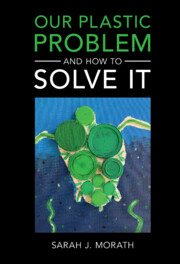Book contents
- Our Plastic Problem and How to Solve It
- Our Plastic Problem and How to Solve It
- Copyright page
- Contents
- Acknowledgments
- Abbreviations
- Introduction
- Part I Plastic in the Environment
- Part II Multimodal Approaches to Solving Our Plastic Problem
- 4 Federal Efforts
- 5 State and Local Efforts
- 6 International Efforts
- 7 Business, NGO, and Individual Efforts
- Part III Innovation and Design
- Index
7 - Business, NGO, and Individual Efforts
from Part II - Multimodal Approaches to Solving Our Plastic Problem
Published online by Cambridge University Press: 17 March 2022
- Our Plastic Problem and How to Solve It
- Our Plastic Problem and How to Solve It
- Copyright page
- Contents
- Acknowledgments
- Abbreviations
- Introduction
- Part I Plastic in the Environment
- Part II Multimodal Approaches to Solving Our Plastic Problem
- 4 Federal Efforts
- 5 State and Local Efforts
- 6 International Efforts
- 7 Business, NGO, and Individual Efforts
- Part III Innovation and Design
- Index
Summary
Many of the efforts to curb plastic pollution discussed in earlier chapters focused on the public sphere and the ways in which governments operating at different levels – local, state, national, and international – can combat plastic pollution. These preceding chapters focused primarily on positive law – the express written commands found in statutes, regulations, judicial decisions, and international agreements – that requires specific action by various actors. Chapter 7 considers the private sphere, exploring governance efforts undertaken by businesses, institutions, nongovernmental organizations (NGOs), and individuals. Because these private sphere efforts take place outside of Congress and the courts, scholars have termed them private governance or, when specific to environmental issues, private environmental governance.
Private efforts to address a perceived shared problem often occur when a collective demand for action by citizen-consumers is met with government inaction. These private efforts can be large scale, such as Fortune-500 companies agreeing to phase out single-use plastics, as well as small scale, such as an individual business or person agreeing to reduce their use of plastic. While these smaller, ad hoc, and individual efforts may seem insignificant, they, in fact, often pave the way for broader, systemic change. Indeed, private environmental governance is premised on individual consumers “voting with their wallets” by selecting products and supporting businesses that reflect their values. Clearly then, private governance and individual action are intertwined and coexistent.
Examples of private – as opposed to public – efforts to prevent plastic pollution are endless. Businesses like Disney, Starbucks, Kroger, and American Airlines have all pledged to eliminate plastic straws or plastic bags. Procter & Gamble, Nestlé, PepsiCo, Unilever, Mars, Petcare, The Clorox Company, The Body Shop, Coca-Cola European Partners, Mondelēz International, and Danone are all participating in a pilot program sponsored by TerraCycle that offers brand-name products in reusable and refillable packaging. In February 2019, Walmart announced a new set of plastic waste reduction commitments, updating earlier commitments made in 2016. In addition to businesses, entities like zoos, professional sports teams, and universities are announcing plans to reduce their plastic footprint.
Many of these commitments are in response to public pressure. Consumers, investors, and everyday citizens (collectively “stakeholders”) are demanding some type of remedial institutional action in the face of the global plastic crisis. The increasing focus of academic scholarship on businesses, institutions, and individual behavior is one signal of the growing role of private efforts in solving environmental problems.
Chapter 7 explains both the benefits and the limitations of these private efforts and provides examples of businesses, non-profits, and individuals working alone and collaboratively to address plastic pollution – taking actions ranging from gathering data to crafting potential solutions. By the end of the chapter, readers will understand the contours of private environmental governance and the role that private entities and individuals are playing in curbing plastic pollution.
Keywords
- Type
- Chapter
- Information
- Our Plastic Problem and How to Solve It , pp. 130 - 158Publisher: Cambridge University PressPrint publication year: 2022

